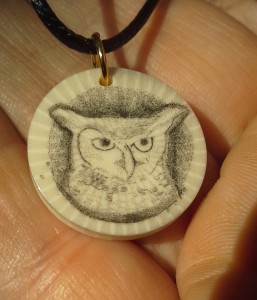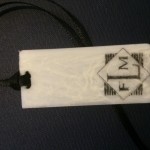
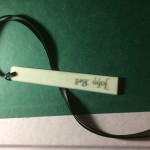 Creating scrimshaw piano key bookmarks in two varieties: “Heads” and “Tails”. Each come with a double satin ribbon tail and either a name or initials of your choice. Available through the Etsy.com store. They’re made from piano key top replacements that are legal in all states so no one in New York or New Jersey (or California) will be exempt. I also have real ivory piano key heads and tails in very short supply, if interested and legal in your state, email me and I can create a custom scrimshaw of your choice. Click on the picture to go to the etsy.com store.
Creating scrimshaw piano key bookmarks in two varieties: “Heads” and “Tails”. Each come with a double satin ribbon tail and either a name or initials of your choice. Available through the Etsy.com store. They’re made from piano key top replacements that are legal in all states so no one in New York or New Jersey (or California) will be exempt. I also have real ivory piano key heads and tails in very short supply, if interested and legal in your state, email me and I can create a custom scrimshaw of your choice. Click on the picture to go to the etsy.com store.
Category: Uncategorized
Alibaba’s Bone – Review of Ox Bone for Scrimshaw
(This article originally appeared in the April 4, 2015 edition of the newsletter)
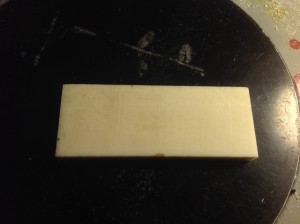
While our dog is a bit upset he wasn’t able to participate in this article, he (and I) really needs more walks and less calories after our incredibly long winter and will get over it.
The easiest place to acquire bone was shared by one of our readers – they go to the big box store for pets and walk down the aisle until they see the nicely cleaned and bleached bones for dogs, picks one up and then goes about cutting, polishing and scrimming it. Smart! Most of the work I’m about to write about is done for you.
The second easiest way is to buy a soup bone from your local grocer or butcher. You can get stew or soup bones in various sizes but for scrimshaw you will want the one that flairs out at one end since this area is not only thicker but also has less voids where capillaries once ran.
After simmering the bone for about an hour and letting it cool, hand it to your four-legged friend to clean the meat out of it and move on to other things. If they haven’t faithfully buried it, the bone should be stripped of most of the meat. Rinse and rewash it, or run it through the dishwasher for a few cycles* .
If you’re going to be gluing this onto or into wood, degreasing the bone is essential. There are two schools of thought when it comes to degreasing: BLTC and natural. BLTC (better living through chemistry) has you soak the bone in white gas or acetone (both flammable, use glass or metal containers and follow safety guidelines and common sense). The natural method is to soak them in a 50/50 mixture of hydrogen peroxide (topical 3%, not the hair bleach type) as noted in “Bonelust: Bad Words: Boil and Bleach“. The third way is to let them sit in the sun and the rain to the oils work out naturally, though this can take several months.
After reading this I wonder if the ox bones I’ve received from Alibaba have been degreased? I’ll be dropping the rest of the lot in a 50/50 mix of H202 just to be sure.
The third way, which we’re finally getting to is to purchase the bone as knife scales. You can get these from Alibaba.com as I have, through Texas Knife Supply,
Amazon, etc.
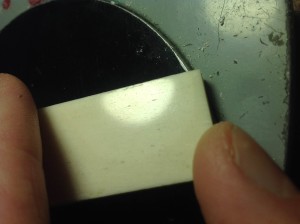
We started with the rough-cut bone, sanding and polishing it to 4000 grit, then coating it with Renaissance Wax and setting it aside for a week. Two days is usually a sufficient rest period for sealing. You can also use beeswax, coating and buffing it into the bone. As you can see here there are micro-fine occlusions where capillaries were. When we polished the bone they became more apparent. I’m curious if stabilized bone has the same qualities.
Marking the bone with various pigments including aquarelle pencil, India Ink and oil paint, I set it to dry for about 30 minutes.
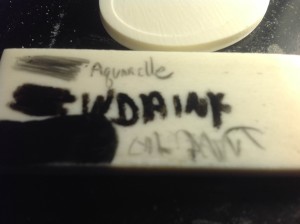
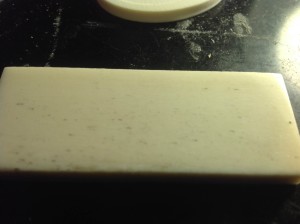
Initially wiping off the bone left some of the India ink, but using a moist towel wiped the rest off easily.
Scrimming:
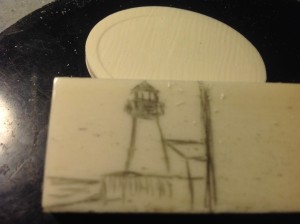
Falling short of my goal to do a lighthouse per day, I have improved with the six I’ve managed to sketch, and the one on the bone I’ll count as my seventh (the whole family got sick one after another, and my dog quickly became jealous of the bucket that was my best friend for a couple of days). The aquarelle pencil marks the bone easily.
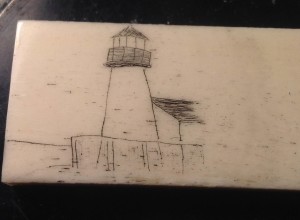
Using the tungsten scrimshaw bit from Coulter Tool the scrimming went easily. Coating the lines with India ink, I took a slurp of coffee and wiped it away, then used a dampened cloth to wipe away the excess. Most of the ink wiped away thanks to my impatience. Next time I’ll ink it, walk the dog so it’s nice and dry, then wipe it away.
After adding more detail I switched over to oil paint to see if it would stand out better but it yielded similar results.
Having started on ivory, any occlusions like those in bone and tagua nut stand out to my eyes, though I’m starting to like the texture of the bone more now, kind of like moving from painting on smooth paper to canvas.
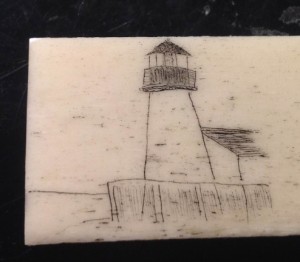
As the bone is too thick at the moment to just cut into cabochons, a cross-cut on the subsequent pieces will need to be performed as well as more sanding and shaping. The material would be excellent for luthiers wanting to make nuts and other parts for their stringed instruments, and would do well for smaller knife handles, also.
Ivory Alternative – Piano Key Tops: Some Aren’t so Great for Scrimshaw

Reclaimed Piano Keys…
Illegal?
Reclaiming piano keys have been a great way to utilize a resource that would otherwise curl away on abandoned pianos or get put into the trash after being replaced. They are often chipped, discolored and are otherwise useless for their intended purpose. Sadly, they are from elephants and though long-since dead, are unsellable in today’s market or will be soon.
Piano key ivory is thin, usually 1mm thick but made great bookmarks or when glued to the outside of a box or zippo lighter made a great miniature canvas for the modern scrimshander.
So far, we have only tried one supplier of alternative ivory keytops and frankly we are not impressed. While the material looks alot like ivory keytops, they fall short for our use.
The piano keytops we purchased online probably work very well for replacement keytops and would blend in quite well with little effort, so realize it’s not a slight on their intended purpose, but for scrimshaw, they are soft – too soft for anyone who wishes to create a treasure to sell or give as a gift. That being said, they are very inexpensive and would work great for beginners or the young if you were to create a class project that students or day campers could try their hands at and would give them a treasure of their own design.
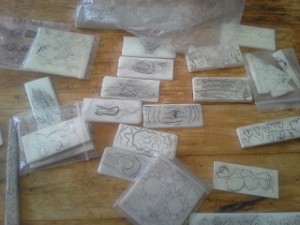 My set of keys have been used by my industrious daughter to create a bagful of her own scrimshaw, and she has had a great time working with it. She also found my other material including some very nice mammoth ivory which now has her beginning scrimshaw art carefully tucked away, since she created them and presented them to me for my birthday. Can’t get angry for that, it was a thoughtful idea, and I wouldn’t sand them down if they were the last pieces of mammoth ivory on earth.
My set of keys have been used by my industrious daughter to create a bagful of her own scrimshaw, and she has had a great time working with it. She also found my other material including some very nice mammoth ivory which now has her beginning scrimshaw art carefully tucked away, since she created them and presented them to me for my birthday. Can’t get angry for that, it was a thoughtful idea, and I wouldn’t sand them down if they were the last pieces of mammoth ivory on earth.
If you need piano key replacements or an inexpensive miniature alternative ivory “canvas” for busy industrious hands you can pick them up here: http://www.ebay.com/itm/Piano-Keytops-Simulated-Ivory-for-replacing-key-top-/110428048307
~~~
Ivory Ban News
iKnifeCollector has introduced two bills to protect knife collectors from the ivory ban
Legislation to stop the U.S. Fish and Wildlife Service from seriously harming millions of Americans by unnecessarily banning interstate commerce of decades-old legal ivory and products containing legal ivory, such as ivory handled and ivory decorated knives, was introduced in both the House and the Senate. Representatives Steve Daines (MT) and Jeff Miller (FL) sponsored H.R. 5052, and Senator Lamar Alexander (TN) sponsored S. 2587. These bills complement a House appropriations bill passed out of sub-committee on July 9th that would defund Fish and Wildlife Service’ enforcement of its irrational new ivory policy that needlessly punishes innocent Americans, while allowing the Administration to protect African elephants and other wildlife from poaching.
Please CALL or EMAIL your Representative and Senators TODAY and ask them to Co-Sponsor H.R. 5052 and S. 2587.
Find your Representative: http://www.house.gov/representatives/find/
Find your Senators: http://www.senate.gov/general/contac…nators_cfm.cfm
From iKnifecollector
~~~
We’re on vacation for a week, may bring some tools and pieces to pass the time. I’ve been working on a couple of cougars, one on “Alternative Ivory” and one on Tagua nut, So far, they’re shaping up nicely, though a snack on a chewy granola type bar has cracked one of my ivories and will be going to get the rest of it extracted later today…
Coming up soon: Casein Revisited: we’ll be reviewing casein made in 3mm sheet form from England (it’s on a tall ship making its way across the “pond” as I write), more ivory alternatives and then we’ll be starting to focus on techniques in the newsletter. Any suggestions, any frustrations you may be experiencing either starting or finishing a piece of scrimshaw? Write to “questions@scrimshaw.com” and we’ll be glad to help
Casein – The “New” Old Plastic for Scrimshaw
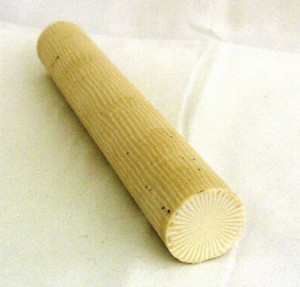 We’ve been testing a “new” old ivory alternative called “casein”.
We’ve been testing a “new” old ivory alternative called “casein”.
This is a plastic made from milk. You’ll find many DIY articles on the net and usually people say “meh.” when they’re finally done, but this was a common alternative at the turn of the last century through about the 1970’s in western Europe. We were able to get a couple of samples from “across the pond” and it’s quite interesting. Extremely dense, polishes beautifully and doesn’t “crater” like typical plastics. We got our samples as rods, mostly used to cut buttons or to turn on a lathe, and went about cutting medallions. It took a long time to cut through it, and the dust is awful – it stays airborne a long time and due to the way it’s made, you’ll definitely want to upgrade your dust masks. Plain casein plastic is made from milk as stated. In order to make it resilient casein is subjected to a formaldehyde bath for up to one year depending on the thickness where the formaldehyde molecules bind with the casein making it harder and more resilient.
The casein is finally rinsed and dried, most of the harmful chemical leaving the end product by off-gassing and repeated rinsing. Ford at one point had experimented making a “plastic car” substituting casein based plastics with soybean and hemp based plastics (see “Henry’s Hobbies“, pg 283).
By the looks of http://pubs.acs.org/doi/abs/10.1021/ie50459a024 the amount of formaldehyde would be negligible for normal handling, but there are no MSDS for this material available that we’ve been able to find, so it is far better to be safe than sorry.
They still make casein plastic knitting needles, and it’s supposed to be some of the finest knitting needles available.
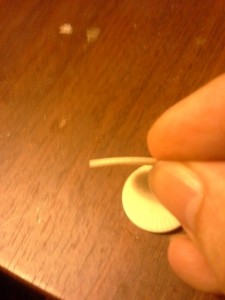
Instead of formaldehyde, companies are creating casein plastic successfully using “glyceraldehyde” which is not considered harmful by OSHA (see http://datasheets.scbt.com/sc-300881.pdf).
We’re probably not going to see this material processed either by formaldehyde or glyceraldehyde any time soon because it can take up to one year for it to be ready, but our source for the casein we’ve been working with is listed at the end.
As stated, casein itself only takes a day or so to make and dry, but it does have to soak for a long time in the fluid for it to permeate completely. Any DIY’ers out there may be able to make a small side business offering cabachons or possibly knife scales provided the total thickness is less than 1/2″ If you look around etsy you can see a lot of vintage casein buttons as well as other useful items that were once made from this material (see Instructibles for the one of many articles on creating your own plastic).
We’ve also come across an “alternative casein” available for turning and possibly for scrimshaw but we haven’t purchased any yet, and are unsure what the “alternative” is: whether it’s an acrylic or polyester made to look like casein or if it’s a “green” casein made from glyceraldehyde. It’s available from “Exotic Blanks” .
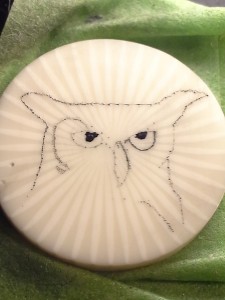 So how well does it scrim? It works great for both line scribing and for stippling. The only problem we found with our samples were small air holes in the faces we’d cut. These would vary from few to numerous, most of them very small and could be incorporated into the scrimshaw design or a “squirt and fill” may also work using a cyanoacrylate glue (crazy glue) and some of the powder from cutting which is a popular way to fill voids in other materials. We found our best piece and scrimmed an owl which you can see in progress. We followed tried coloring the back of the template and piercing the paper once it was secured and it worked quite well.
So how well does it scrim? It works great for both line scribing and for stippling. The only problem we found with our samples were small air holes in the faces we’d cut. These would vary from few to numerous, most of them very small and could be incorporated into the scrimshaw design or a “squirt and fill” may also work using a cyanoacrylate glue (crazy glue) and some of the powder from cutting which is a popular way to fill voids in other materials. We found our best piece and scrimmed an owl which you can see in progress. We followed tried coloring the back of the template and piercing the paper once it was secured and it worked quite well.
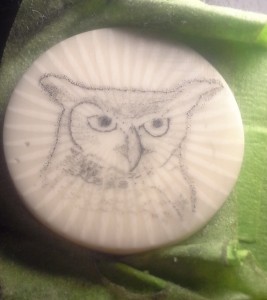 Most of the owl is done in the stipple technique, though we tried a few lines going “dot-to-dot” on the upper right hand side of the owl’s head. Very little cratering, and the material holds both ink and aquarelle black pencil well.
Most of the owl is done in the stipple technique, though we tried a few lines going “dot-to-dot” on the upper right hand side of the owl’s head. Very little cratering, and the material holds both ink and aquarelle black pencil well.
We’d like to find this material in sheet form at 3/16″ thickness, and if you come across a supplier, please let us know.
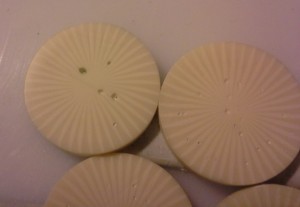
Casein in rod form is available from http://www.johnberkeley.biz/page15.html
Further reading on Casein Formaldehyde: Green Plastics: An Introduction to the New Science of Biodegradable Plastics

Kraken Blog – More Shading
Adding more shading, you can see that in many ways, you are destined to work with the darkest(deepest) stipple-dots you created when you first began your piece. The initial dots were done with my original tool, just sharpened, while the subsequent work was done with the Coulter tool (see tools section). It will take a few more pieces before I am familiar with this new tool and can master it’s subtleties. with an angle of approximately 20 degrees going to an incredibly sharp and hard point, this tool will pierce paper effortlessly and create a dot on a piece of ivory with little trouble. Experience will allow a subtler initial stipple-dot so shading can be made more realistically. Click here for a larger view
